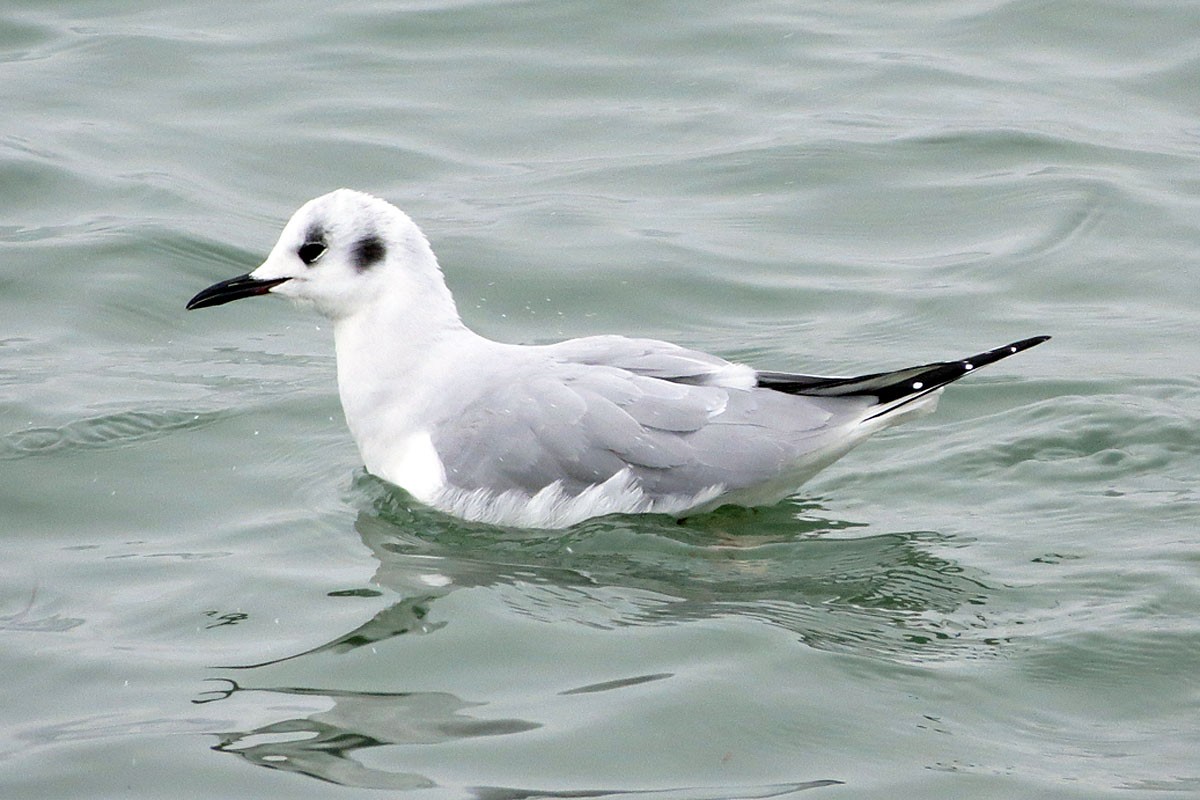Bonaparte's Gull
A species of Masked Gulls Scientific name : Chroicocephalus philadelphia Genus : Masked Gulls
Bonaparte's Gull, A species of Masked Gulls
Botanical name: Chroicocephalus philadelphia
Genus: Masked Gulls
Content
Description People often ask General Info
 Photo By Don Faulkner , used under CC-BY-SA-2.0 /Cropped and compressed from original
Photo By Don Faulkner , used under CC-BY-SA-2.0 /Cropped and compressed from original Description
Bonaparte's gull is among the smallest of the gull species; only little gull and Saunders's gull are smaller. Adults range from 28 to 38 cm (11 to 15 in) in length, with a wingspan of 76–84 cm (30–33 in) and a body mass of 180–225 g (6.3–7.9 oz). There is no difference in plumage or bare part colour between the sexes, though males tend to be heavier than females. Bonaparte's gull is smaller-bodied, smaller-headed, and smaller-billed than the other common hooded gulls of North America. The adult has grey upperparts and white underparts; its wingtips are black above and pale below. In breeding plumage, it has a slaty black hood, which it loses in non-breeding plumage. Its short, thin bill is black, and its legs are orangish-red. In their first summer, the appearance of Bonaparte's gull is similar to that in its first winter, but paler due to wear. Fewer than 5% of Bonaparte's gulls acquire a dark hood in their first summer, and on those that do, the hood is duller than on breeding adults. 
Size
30-36 cm (12-14 in)
Colors
Black
Gray
White
Life Expectancy
18 years
Nest Placement
Tree
Clutch Size
2 - 3 eggs
Incubation Period
1 brood
Number of Broods
22 - 25 days
Nestling Period
6 - 7 days
Feeding Habits
Bonaparte's Gull predominantly feed on small fish, invertebrates, and insects. They exhibit diverse feeding behaviors, including dipping and diving in water, and kleptoparasitism. During nonbreeding seasons, they are known to group and feed intensively on abundant prey like emerald shiners. They consume salmon eggs, fry, and herring in Western North America, and feed on marine worms, shrimp, and tiny crustaceans in other regions. Bonaparte's Gull also exploit agricultural fields for earthworms and insects and capture aerial insects in flight during the breeding season.
Habitat
Bonaparte's Gull thrive in boreal forest openings by lakes, streams, and marshes in Canada and Alaska, preferring tree nests—a rarity among gulls. They seek low-altitude taiga environments, favoring coniferous trees for nesting. Their diet leads them to forage for flying insects over marshes and open waters, and even above trees. Migratory flocks adapt to a range of aquatic habitats, from inland sewage plants to offshore areas, including unfrozen Great Lakes. Winter finds them on rivers, bays, and coastlines, often traveling in search of food, and they may roost on water surfaces or in sheltered inlets.
Nest Behavior
Bonaparte's Gull demonstrates variable nesting behavior, building nests at different heights and locations. They exhibit traditional egg-laying patterns and engage in shared parental duties.
Nest Characteristics
Bonaparte's Gull constructs its nest near water in conifers or occasionally on the ground. Elevated nests, 6-56 feet high, comprise bark, twigs, and branches, lined with lichen and moss. Ground nests feature twigs, mosses, grasses, and earth. Nests measure about 10-15 inches across, 3-5 inches tall with a central depression around 1.5 inches deep.
Dite type
Aquatic invertebrate eater
People often ask
General Info
Feeding Habits
Bird food type
Sounds
Call
Recording location: United States
Behavior
Bonaparte's Gull exhibit remarkable agility due to their fine bill, streamlined body, and narrow wings, allowing for precise prey capture and adept maneuvering in dense flocks. Their foraging includes skimming from the air, hunting on land, and unique 'conveyor belt' technique over water surfaces. They court on breeding grounds, performing aerial displays and calls. Both sexes contribute to nest building, incubation, and chick rearing. Bonaparte's Gull form tight, social flocks for migration, behaving more cohesively than larger gulls.
Distribution Area
Bonaparte's gull breeds in boreal forest across southern Alaska and much of interior western Canada, as far east as central Quebec and south to within 320 km (200 mi) of the United States/Canada border. It avoids dense stands of conifers, instead choosing more open areas, such as the treed edges of bogs, fens, marshes, ponds, or islands. It typically nests within 60 m (200 ft) of open water. It winters along the coasts of North America, and in the Great Lakes. It is a rare vagrant to western Europe and the Azores, where it generally associates with black-headed gulls. In 2017 a breeding pair was spotted on Iceland. 
Species Status
Because of its extremely large range and its increasing population, Bonaparte's gull is listed as a species of least concern by the International Union for the Conservation of Nature. In North America, it is protected by the Migratory Bird Treaty Act. Because it occurs in Europe and Africa only as a vagrant, it is not protected by the Agreement on the Conservation of African-Eurasian Migratory Waterbirds. The species is known to be preyed upon by peregrine falcons. Like many birds, it hosts a number of internal and external parasites. The linguatulid species Reighardia sternae, a tiny, worm-like crustacean, is sometimes found in the gull's air sacs. The acanthocephala worm Corynosoma bipapillum is sometimes found in the bird's posterior gut, as is the intestinal worm Echinostomum spinulosum. Gigantobilharzia lawayi, a schistosome (or blood fluke) may be carried in the capillaries. Externally, it is known to carry several species of lice, including Actornithophilus funebre, Degeeriella atrimarginata, Degeeriella punctata, Menopon species, and Philopterus gonothorax. 
Scientific Classification
Phylum
Chordates Class
Birds Order
Shorebirds Family
Gulls Genus
Masked Gulls Species
Bonaparte's Gull